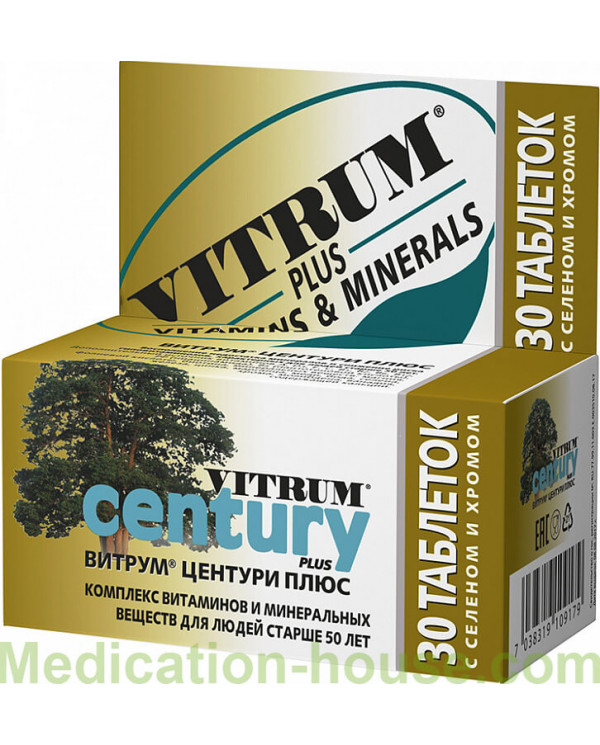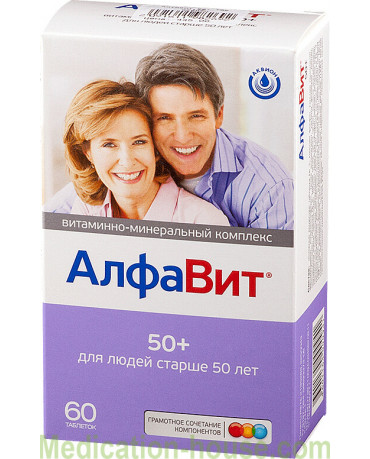Instruction for Vitrum Century plus
You can buy Vitrum Century plus here
Composition
1 tablet weighing 1 430 mg contains:
vitamin A - 1888.0 mcg
iodine - 150.0 mcg
Beta carotene - 112.0 mcg
calcium - 200.0 mg
Vitamin B 1 - 1.5 mg
potassium - 80.0 mg
Vitamin b 2 - 1.7 mg
phosphorus - 48.0 mg
Vitamin B 3 - 20.0 mg
magnesium - 100.0 mg
Vitamin B 6 - 3.0 mg
Iron - 9.0 mg
Vitamin B 12 - 6.0 mcg
copper - 2.0 mg
Vitamin D 3 - 10.0 mcg
zinc - 15.0 mg
vitamin E - 30.1 mg
Manganese - 2.5 mg
vitamin c - 60.0 mg
vanadium - 10.0 mcg
pantothenic acid - 10.0 mg
Boron - 0,150 mg
folic acid - 200.0 mcg
selenium - 20.0 mcg
biotin - 30.0 mcg
molybdenum - 25.0 mcg
Vitamin K 1 - 10.0 mcg
chromium - 100.0 mcg
chlorine - 72.0 mg
Ingredients in Vitrum Century plus: Calcium carbonate, calcium phosphate dibasic dihydrate, magnesium oxide, potassium chloride, ascorbic acid, DL-alpha-tocopherol acetate, filler - microcrystalline cellulose, stabilizer - stearic acid, anti-spouting agent - silicon dioxide, shell of Opadry White II tablet (stabilizer - hydroxypropylcellulose, dye - titanium dioxide, filler - polydextrose, anti-spiking agent - talc, maltodextrin, with medium triglycerides), iron fumarate, niacinamide, zinc oxide, stabilizer - croscarmellose sodium, retinol acetate, D-pant tenate calcium, stabilizer - magnesium stearate, chromium chloride, manganese sulfate monohydrate, cholecalciferol, pyridoxine hydrochloride, D-biotin, copper oxide, folic acid, thiamine hydrochloride, potassium iodide, riboflavin, sodium borate, sodium molybdate metavananate, phylloquinone, sodium selenate, cyanocobalamin, beta-carotene.
Properties
Scientifically proven properties of vitamins, minerals, flavonoids, polyphenolic compounds *.
Vitrum Century plus is a complex of vitamins and minerals that meet the needs of people over 50 years old.
Maintains normal physical and mental performance. Contributes to the protection of the body against premature aging.
An antioxidant complex consisting of vitamins A, C, E, beta-carotene, zinc, selenium, copper and manganese protects the body from the destructive action of free radicals.
Vitamin A provides the normal function of the organ of vision, the structural integrity of the tissues and the proper level of immunity.
Beta-carotene is a source for the synthesis of vitamin A, protects cell membranes from lipid oxidation products.
Vitamin C is a water-soluble antioxidant with a powerful reducing effect. Increases non-specific resistance of the body.
Vitamin E antioxidant, prevents lipid peroxidation. Necessary for the biosynthesis of heme and proteins, tissue respiration processes, affects vascular tone and permeability.
Selenium functions through the selenprotein, the main of which is glutadione peroxidase. Selenium interacts with vitamin E in protective processes.
Vitamins of group B are components of complex enzymatic systems that ensure the normal metabolism of proteins, fats and carbohydrates. The biochemical and physiological processes in which these vitamins are involved are closely interrelated. Often there are combined manifestations of the deficiency of several vitamins of this group, so they must be taken in combination.
Vitamin B 1 is a coenzyme of carbohydrate and amino acid metabolism enzymes with branched chains. Ensures the normal functioning of the nervous system, cardiac activity and the endocrine glands.
Vitamin B 2 is part of the flavin enzymes involved in oxygen transport (tissue respiration) and the formation of ATP in mitochondria, and numerous redox processes.
Vitamin B 6 as a coenzyme is involved in the metabolism of amino acids, glycogen, sphingoid bases and the synthesis of neurotransmitters.
Pantothenic acid is a component of coenzyme A and phosphopanthothein, plays a significant role in the processes of endothelial regeneration and fatty acid metabolism.
Vitamin B 3 (nicotinamide) functions as a cosubstrate or coenzyme dehydrogenase to transport the hydrogen ion.
Vitamin B 12 is necessary for the synthesis of nucleotides and fatty acid metabolism, methylation processes. In combination with folic acid, it provides a normal hematological and neurological status.
Folic acid is a coenzyme of one-carbon carriers in the metabolism of nucleic acids and amino acids. Stimulates erythropoiesis, is involved in the synthesis of amino acids, nucleic acids, purines and pyrimidines, as well as in the metabolism of choline.
Biotin is part of the enzymes that regulate protein, fat and carbohydrate metabolism. Participates in the synthesis of purine nucleotides. It is a source of sulfur, which is involved in the synthesis of collagen.
Adequate intake of vitamin K 1 is necessary for the prevention of osteoporosis, has a regulating effect on blood coagulation processes.
Vitamin D, calcium, magnesium, zinc, copper, manganese and boron help prevent the development of osteoporosis and its complications (primarily bone fractures).
Without a sufficient intake of iodine, the synthesis of thyroid hormones and the regulation of many metabolic processes, especially protein synthesis and enzymatic activity, are disturbed. The target organs for them are the brain, the muscles, the heart, the pituitary gland and the kidneys.
Iron is part of numerous enzymes responsible for the transport of oxygen to tissues: hemoproteins (hemoglobin, myoglobin, cytochromes), iron-sulfur enzymes (flavoproteins, hemoflavoproteiniv), proteins for storage and transport of iron (transferrin, lactoferrin, ferritin, hemosiderin) and others . A sufficient supply of iron ensures the delivery of oxygen to the tissues and the functioning of the respiratory chain, increases nonspecific resistance.
Vanadium can inhibit the synthesis of fatty acids, suppress the formation of cholesterol.
Molybdenum is needed to maintain the normal state of the dental tissue and provides caries prevention; regulate metabolic and growth processes; stimulates enzymes that provide the synthesis of ascorbic acid and normal tissue respiration.
Chromium is involved in glucose metabolism, enhancing the action of insulin.
Recommendations for use
Vitrum Century plus can be recommended for the correction of adult diets as an additional source of vitamins: A, D 3, E, C, B 1, B 2, B 6, B 12, B 3 (nicotinamide), 5 (pantothenic acid), folic acid , biotin, and minerals: magnesium, iron, zinc, manganese, copper, iodine, selenium, chromium, molybdenum, vanadium, contains calcium.
Warning
Vitrum Century plus should not be used in people with individual intolerance to the components of the product, pregnant women or women who are breastfeeding. Persons with thyroid disease should consult an endocrinologist.
Vitrum Century plus is not intended to diagnose, treat, cure or prevent any disease; it should not be used as a substitute for various diets.
Do not exceed the recommended daily dose of Vitrum Century plus. Do not use after the expiration date printed on the package.
Before use, it is recommended to consult a doctor.
It is not a drug.
Dosage and administration
Adults take 1 tablet of Vitrum Century plus with food.
Duration of consumption: 2-3 weeks. If necessary, you can repeat a month after consultation with the doctor.
Release form
tablets, film coated, weight of 1430 mg, on 30 tablets of Vitrum Century plus in a bottle.
Storage conditions
Keep out of the reach of children at a temperature of +15° C to +25° C and at a relative humidity not exceeding 60%.
Terms of sell
You don't need a prescription to buy Vitrum Century plus.


